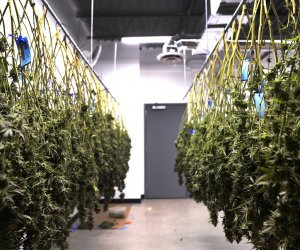Cultivating Hemp
Hemp (from Old English hænep) is the name of the soft, durable fibre that is cultivated from plants of the Cannabis genus, cultivated for commercial use. Not to be mistaken with Abaca or ‘Manila Hemp’, a relative of the banana plant which once replaced hemp’s use for rope.
Soils
Hemp will show higher yields in higher quality soils, with sufficient readily available nutrients, favorable water balance and good water permeability. The ideal soil acidity is between 5.8 and 6.0 pH. Very rich black mollisols, brown rendzina and brown steppe soils have favorable water balance, good water permeability and an excellent nutrient-accumulation potential. Hemp may react poorly to residual herbicides in soil, however with time it should be possible to develop a reasonable yield of hemp on soils previously damaged by chemical usage, helping to improve soil health, and supply industrial inputs for building products or paper, rather than as a food crop.
Nutrients for Hemp
Nitrogen is considered the most important nutrient for hemp, which needs adequate readily available nitrogen throughout the entire vegetative period to achieve high yields. Including leguminous crops in rotation and addition of natural organic fertilizers if necessary can provide this. Excess N can result in reduced fibre quality and quantity. Hemp is a nitrophilic crop, irrigated crops using in excess of 200 units of Nitrogen, 120 units of Potassium and 40 units of Phosphorus.Hemp requires adequate Calcium and therefore pH should be rectified by liming if acidity limits the availability of any of these nutrients. Phosphorous and potassium are also quite important relating to elasticity and tensile strength of fibre cells or bundles and fibre quality respectively. Mulches, seaweeds, fly ash, bird and animal manures, comfrey, rock dusts, treated waste water, lime, composite, and rotational crop choice, can all help improve the nutrient qualities of soils. Hemp requires less than 1/3rd of the nitrogen and less than ½ of the phosphoric acid that does cotton. Hemp removes minimal ingredients permanently from the soil in comparison to wheat, corn, tobacco and such like.
Pre-crop
Legumes, clovers, lupins will enhance nitrogen levels and organic matter content of soils
Companion Crops
Interplanting hemp with mixed tree species will provide wind protection, improve water balance and can themselves be utilized as valuable crops. In Australia, using plants such as native Acacias can also provide mulch high in nitrogen. Hemp can be grown on the same land more than once, however like any crop – rotation is preferred and recommended.
Soil Preparation
Tillage methods that retain precipitation, incorporate the nutrients into the soil, sustain porosity and keep a smooth surface are recommended
Yeomans type ploughing can improve compacted soils, aerating and de-compacting soils whilst protecting soil biological processes.
Crops can be grown with no-tillage methods such as espoused in the ‘One Straw Revolution’, by Matsuoba Fukuoka, and should be applicable to hemp production in the long term.
Hemp is able to extract heavy metal from the soil in amounts higher than many other agricultural crops. This has been shown by the ‘mop cropper’ Dr Keith Bolton in Australia.
Gross primary biomass increments up to 23 t/ha and CO2 sequestration range between 7.6 tC/ha and 11.5 tC/ha.
Temperature and irrigation
The range for optimal growth is between 19 and 25°c (66°- 77°F).
50-70 cm of precipitation are recommended for good plant growth and high yields, with 25-30 cm of that being during the vegetative period, or other adequate water, such as a water table within a metre of the surface. However hemp has shown reasonable yields in dry land farming trials. If irrigation is used it is important to avoid flood irrigation on early seedlings.
Hemp Seeds
Fresh, clean, bright, plump glossy seed that is one year old is ideal. Test for fertility rates if 2 years or more old.
Planting Hemp
Hemp in the southern hemisphere temperate regions is usually sown between September to November. In the northern hemisphere hemp is generally sown in the spring – from March to May. A fertile astrological sign, during the first or second quarter moon is recommended An exact date is chosen with all these factors in mind, including precipitation.
Sow Rate
Fibre crop approximately 80 kg/Ha Seed crop approximately 40 kg/Ha Or 100-200 plants/m2
Planting at the higher density results in minimal branching, improves the quality bast fibre for textile use, almost complete ground cover and weed suppression. Wider spacing of plants allows for more branching and higher seed yields.
Sow Method
Regularly spaced plantings assist uniformity of crop qualities. Seed depth 2-5 cm, with uniformity preferred. Deeper for light soils. Normal combine seeder can be used. Both broadcast and drill sowing have been used successfully.
Irrigation
Only if dry first few weeks or general very low rainfall. Avoid flooding young crop. Use of treated waste water for
irrigation will also increase soil nitrogen levels (although food standards need to be followed for a crop intended for human consumption). Ensuring adequate irrigation is often well rewarded.
Yield
Growth relates to levels of photosynthetically active radiation including heat. Results of Victorian and NSW hemp trials have shown yields of 7-14 ton dry stem/Ha, plant height can easily reach three meters. Overseas seed crops have been reported to readily yield 500 – 1000 kg seed/Ha, with higher seed yields being reported from newer cultivar
Harvesting Hemp
Harvesting is 3-4 months. Fibre hemp is ready before seed hemp. If being used for textiles the plants should be harvested a little earlier – at the first appearance of the indications of bloom upon the male stalks.
Smallholder plots are usually harvested by hand. The plants are cut at 2 to 3 cm above the soil and left on the ground to dry. Traditionally hemp was gathered in stooks and leaned in a ‘tipi’ like structure to air dry. Mechanical harvesting is now common, using specially adapted cutter- binders or simpler cutters. One harvesting unit has been made from a specially modified Kemper front with an added billetising unit designed to handle the hemp stalks, even in high yielding paddocks, chopping it into 600 mm lengths ready for infield drying, raking and baling.
The cut hemp is laid in swathes to dry for up to four days. This was traditionally followed by retting, either water retting (the bundled hemp floats in water) or dew retting (the hemp remains on the ground and is affected by the moisture in dew moisture, and by molds and bacterial action). Modern processes use steam and machinery to separate the fibre, a process known as thermo-mechanical pulping.



